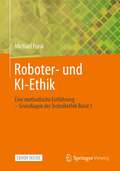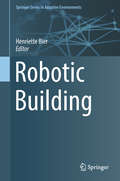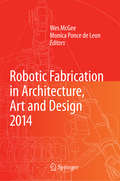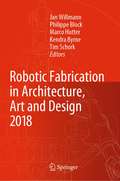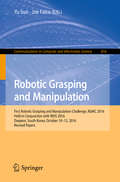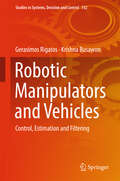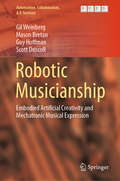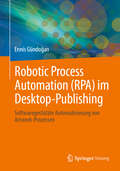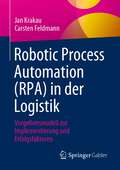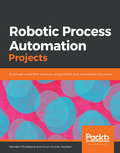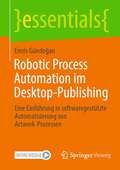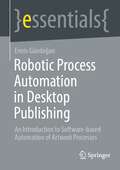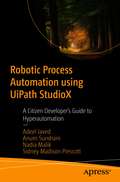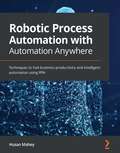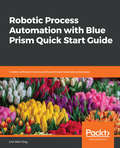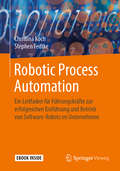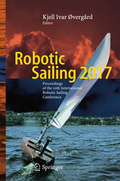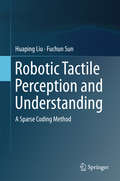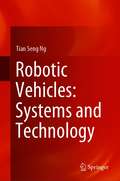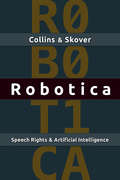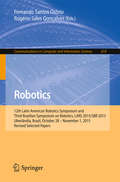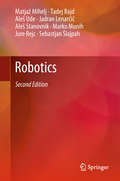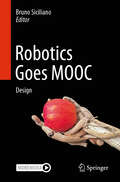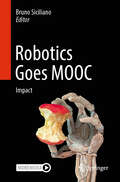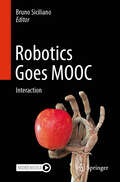- Table View
- List View
Roboter- und KI-Ethik: Eine methodische Einführung – Grundlagen der Technikethik Band 1
by Michael FunkWas ist die Ethik der Roboter? Was ist KI-Ethik? Was sind „moralische Maschinen“? Welchen Gesetzen sollen sie folgen? Haben wir die Roboter, die wir brauchen, und brauchen wir die Roboter, die wir haben?In vorliegendem Buch werden Grundlagen der Ethik im Umgang mit Robotern, Drohnen und KI allgemeinverständlich dargestellt. Hierzu zählt die Unterscheidung von Moral, Ethik und Ethos sowie deren Anwendung auf Menschen und Maschinen. Kriterien, Fehlschlüsse und Robotergesetze werden vorgestellt, wie auch in die umfassende Gegenwartsdebatte übersichtlich eingeführt. Grafiken und Beispiele bieten Orientierung in einem hochaktuellen und komplexen Feld.Als methodische Einführung richtet sich vorliegendes Buch an Ingenieurwissenschaftler*innen, Informatiker*innen und Geisteswissenschaftler*innen im Berufsalltag, aber auch an interessierte Lai*innen, die Grundlagen der Ethik kennen lernen wollen. Es bildet den ersten, in sich abgerundeten Teil der Buchreihe Grundlagen der Technikethik.Mit einem Geleitwort von Yvonne Hofstetter.
Robotic Building (Springer Series in Adaptive Environments)
by Henriette BierThe first volume of the Adaptive Environments series focuses on Robotic Building, which refers to both physically built robotic environments and robotically supported building processes. Physically built robotic environments consist of reconfigurable, adaptive systems incorporating sensor-actuator mechanisms that enable buildings to interact with their users and surroundings in real-time. These require Design-to-Production and Operation chains that are numerically controlled and (partially or completely) robotically driven. From architectured materials, on- and off-site robotic production to robotic building operation augmenting everyday life, the volume examines achievements of the last decades and outlines potential future developments in Robotic Building.This book offers an overview of the developments within robotics in architecture so far, and explains the future possibilities of this field. The study of interactions between human and non-human agents at building, design, production and operation level will interest readers seeking information on architecture, design-to-robotic-production and design-to-robotic-operation.
Robotic Fabrication in Architecture, Art and Design 2014
by Wes Mcgee Monica Ponce de LeonRobotic automation has become ubiquitous in the modern manufacturing landscape, spanning an overwhelming range of processes and applications-- from small scale force-controlled grinding operations for orthopedic joints to large scale composite manufacturing of aircraft fuselages. Smart factories, seamlessly linked via industrial networks and sensing, have revolutionized mass production, allowing for intelligent, adaptive manufacturing processes across a broad spectrum of industries. Against this background, an emerging group of researchers, designers, and fabricators have begun to apply robotic technology in the pursuit of architecture, art, and design, implementing them in a range of processes and scales. Coupled with computational design tools the technology is no longer relegated to the repetitive production of the assembly line, and is instead being employed for the mass-customization of non-standard components. This radical shift in protocol has been enabled by the development of new design to production workflows and the recognition of robotic manipulators as "multi-functional" fabrication platforms, capable of being reconfigured to suit the specific needs of a process. The emerging discourse surrounding robotic fabrication seeks to question the existing norms of manufacturing and has far reaching implications for the future of how architects, artists, and designers engage with materialization processes. This book presents the proceedings of Rob|Arch2014, the second international conference on robotic fabrication in architecture, art, and design. It includes a Foreword by Sigrid Brell-Cokcan and Johannes Braumann, Association for Robots in Architecture. The work contained traverses a wide range of contemporary topics, from methodologies for incorporating dynamic material feedback into existing fabrication processes, to novel interfaces for robotic programming, to new processes for large-scale automated construction. The latent argument behind this research is that the term 'file-to-factory' must not be a reductive celebration of expediency but instead a perpetual challenge to increase the quality of feedback between design, matter, and making
Robotic Fabrication in Architecture, Art and Design 2018: Foreword by Sigrid Brell-Çokcan and Johannes Braumann, Association for Robots in Architecture
by Philippe Block Marco Hutter Jan Willmann Kendra Byrne Tim SchorkThe book presents research from Rob|Arch 2018, the fourth international conference on robotic fabrication in architecture, art, and design. In capturing the myriad of scientific advances in robotics fabrication that are currently underway – such as collaborative design tools, computerised materials, adaptive sensing and actuation, advanced construction, on-site and cooperative robotics, machine-learning, human-machine interaction, large-scale fabrication and networked workflows, to name but a few – this compendium reveals how robotic fabrication is becoming a driver of scientific innovation, cross-disciplinary fertilization and creative capacity of an unprecedented kind.
Robotic Grasping and Manipulation: First Robotic Grasping and Manipulation Challenge, RGMC 2016, Held in Conjunction with IROS 2016, Daejeon, South Korea, October 10–12, 2016, Revised Papers (Communications in Computer and Information Science #816)
by Yu Sun Joe FalcoThis book constitutes the refereed proceedings of the First Robotic Grasping and Manipulation Challenge, RGMC 2016, held at IROS 2016, Daejeon, South Korea, in October 2016.The 13 revised full papers presented were carefully reviewed and are describing the rules, results, competitor systems and future directions of the inaugural competition. The competition was designed to allow researchers focused on the application of robot systems to compare the performance of hand designs as well as autonomous grasping and manipulation solutions across a common set of tasks. The competition was comprised of three tracks that included hand-in-hand grasping, fully autonomous grasping, and simulation.
Robotic Manipulators and Vehicles: Control, Estimation And Filtering (Studies in Systems, Decision and Control #152)
by Krishna Busawon Gerasimos RigatosThis monograph addresses problems of:• nonlinear control, estimation and filtering for robotic manipulators (multi-degree-of freedom rigid-link robots, flexible-link robots, underactuated, redundant and cooperating manipulators and closed-chain robotic mechanisms); and• nonlinear control, estimation and filtering for autonomous robotic vehicles operating on the ground, in the air, and on and under water, independently and in cooperating groups.The book is a thorough treatment of the entire range of applications of robotic manipulators and autonomous vehicles. The nonlinear control and estimation methods it develops can be used generically, being suitable for a wide range of robotic systems. Such methods can improve robustness, precision and fault-tolerance in robotic manipulators and vehicles at the same time as enabling the reliable functioning of these systems under variable conditions, model uncertainty and external perturbations.
Robotic Musicianship: Embodied Artificial Creativity and Mechatronic Musical Expression (Automation, Collaboration, & E-Services #8)
by Scott Driscoll Gil Weinberg Mason Bretan Guy HoffmanThis book discusses the principles, methodologies, and challenges of robotic musicianship through an in-depth review of the work conducted at the Georgia Tech Center for Music Technology (GTCMT), where the concept was first developed. Robotic musicianship is a relatively new research field that focuses on the design and development of intelligent music-making machines. The motivation behind the field is to develop robots that not only generate music, but also collaborate with humans by listening and responding in an expressive and creative manner. This combination of human and machine creativity has the potential to surprise and inspire us to play, listen, compose, and think about music in new ways. The book provides an in-depth view of the robotic platforms designed at the GTCMT Robotic Musicianship Group, including the improvisational robotic percussionists Haile and Shimon, the personal robotic companion Shimi, and a number of wearable robots, such as the Robotic Drumming Prosthesis, The Third Drumming Arm, and the Skywalker Piano Hand. The book discusses numerous research studies based on these platforms in the context of five main principles: Listen like a Human, Play Like a Machine, Be Social, Watch and Learn, and Wear It.
Robotic Process Automation (RPA) im Desktop-Publishing: Softwaregestützte Automatisierung von Artwork-Prozessen
by Ennis GündoğanDieses Buch soll dem Leser verschiedene Automatisierungsmöglichkeiten im Bereich Desktop-Publishing aufzeigen und ihn motivieren, diese in Ihren Arbeitsprozess einzube-ziehen, um die Effizienz und Effektivität ihrer Gestaltungs- bzw. Produktionsprozesse zu erhöhen. Die Methoden reichen von kleinen Hilfsmitteln wie in DTP-Software wie Adobe InDesign integrierten Skripten zur automatischen Generierung grafischer Assets bis hin zu komplexen Software-Infrastrukturen, die das automatisierte Publizieren von Tausenden von Dokumenten realisieren. Das Buch soll möglichst viele Szenarien abdecken, ein breites Publikum ansprechen und weitestgehend alle Themen rund um die Automatisierung im Desktop-Publishing kurz und prägnant abdecken. Ebenso soll das Buch mithilfe von Fall-beispielen die Effizienz und Effektivität der Automatisierung verifizieren und mehrere Blickwinkel auf DTP-bezogene Unterthemen bieten.
Robotic Process Automation (RPA) in der Logistik: Vorgehensmodell zur Implementierung und Erfolgsfaktoren
by Carsten Feldmann Jan KrakauRobotic Process Automation (RPA) bezeichnet Software-Roboter (Bots), die sich wiederholende, regelbasierte Aufgaben in einem Geschäftsprozess automatisieren. Dieses Buch beschreibt Anwendungsbereiche für RPA in der Logistik und ein Vorgehensmodell zur Implementierung von Bots in Logistikprozessen. Es beantwortet die Fragen: Was sind geeignete Anwendungsfälle für RPA in der Logistik? Welche Kriterien unterstützen die Auswahl geeigneter Prozesse? Und wie sollte ein Einführungsleitfaden gestaltet sein, um ein Implementierungsprojekt unter Berücksichtigung kritischer Erfolgsfaktoren systematisch zu unterstützen? Das Buch ist das Ergebnis eines anwendungsorientierten Forschungsprojekts zur automatisierten Ausfuhranmeldung zollpflichtiger Exportware. Es richtet sich gleichermaßen an Praktiker, Studierende und Wissenschaftler.
Robotic Process Automation Projects: Build real-world RPA solutions using UiPath and Automation Anywhere
by Nandan Mullakara Arun Kumar AsokanLearn RPA by building business solutions such as ERP and CRM automation, software robots, and intelligent process automation from scratch Key Features Use popular RPA tools Automation Anywhere A2019 and UiPath, for real-world task automation Build automation solutions for domains such as System Administration, Finance, HR, Supply Chain, and Customer Relations Extend your RPA capabilities by implementing Intelligent process automation with APIs and AI Book Description Robotic Process automation helps businesses to automate monotonous tasks that can be performed by machines. This project-based guide will help you progress through easy to more advanced RPA projects. You'll learn the principles of RPA and how to architect solutions to meet the demands of business automation, along with exploring the most popular RPA tools - UiPath and Automation Anywhere. In the first part, you'll learn how to use UiPath by building a simple helpdesk ticket system. You'll then automate CRM systems by integrating Excel data with UiPath. After this, the book will guide you through building an AI-based social media moderator using Google Cloud Vision API. In the second part, you'll learn about Automation Anywhere's latest Cloud RPA platform (A2019) by creating projects such as an automated ERP administration system, an AI bot for order and invoice processing, and an automated emergency notification system for employees. Later, you'll get hands-on with advanced RPA tasks such as invoking APIs, before covering complex concepts such as Artificial Intelligence (AI) and machine learning in automation to take your understanding of RPA to the next level. By the end of the book, you'll have a solid foundation in RPA with experience in building real-world projects. What you will learn Explore RPA principles, techniques, and tools using an example-driven approach Understand the basics of UiPath by building a helpdesk ticket generation system Automate read and write operations from Excel in a CRM system using UiPath Build an AI-based social media moderator platform using Google Cloud Vision API with UiPath Explore how to use Automation Anywhere by building a simple sales order processing system Build an automated employee emergency reporting system using Automation Anywhere Test your knowledge of building an automated workflow through fun exercises Who this book is for This RPA book is for enterprise application developers, software developers, business analysts, or any professional who wants to implement RPA across various domains of the business. The book assumes some understanding of enterprise systems. Computer programming experience will also be beneficial.
Robotic Process Automation im Desktop-Publishing: Eine Einführung in softwaregestützte Automatisierung von Artwork-Prozessen (essentials)
by Ennis GündoğanDie Automatisierung dient als eine wesentliche Komponente in der Wirtschaft, um Unternehmensziele mit qualitativ und quantitativ besseren Ergebnissen zu erreichen. Auch im Bereich des Desktop-Publishings (DTP) ist der Einsatz von Automatismen unabdingbar, um die Kosteneinsparung im Unternehmen und die Verbesserung der Endergebnisse durch Standardisierungen und Fehlerreduzierungen sowie die Entlastung der Mitarbeiter bezüglich aufwendiger und monotoner Aufgaben zu erreichen. Das vorliegende essential setzt das Ziel, die vielfältigen Möglichkeiten der Automatisierung im Bereich des DTP zusammenzufassen und legt dabei den Fokus auf sich wiederholende Artwork-Prozesse in der Druckvorstufe.
Robotic Process Automation in Desktop Publishing: An Introduction to Software-based Automation of Artwork Processes (essentials)
by Ennis GündoğanAutomation serves as an essential component in business to achieve company goals with qualitatively and quantitatively better results. The use of automation is also in the field of desktop publishing (DTP) indispensable to achieve cost savings in the company and to improve the final results through standardization and error reduction, as well as to relieve employees with regard to laborious and monotonous tasks. This essential aims to summarize the many possibilities of automation in the field of DTP, focusing on repetitive artwork processes in prepress.
Robotic Process Automation using UiPath StudioX: A Citizen Developer’s Guide to Hyperautomation
by Adeel Javed Anum Sundrani Nadia Malik Sidney Madison PrescottLearn about Robotic Processing Automation (RPA) and how to build bots using UiPath. This book uses hands-on examples to explain the basics of UiPath and then walks you through real-world prototypes for testing your knowledge.Organizations around the world are implementing RPA in some capacity, and there is a shortage of RPA developers in the market. Analysts predict that the RPA market size will be worth $4 Billion by 2025. With UiPath as one of the three major players in the RPA market, professionals and students can use this book to get ahead of the curve.This book helps you kick-start your automation journey with a special focus on one of the most popular RPA tools: UiPath. Robotic Process Automation using UiPath explains in detail the various features and functionalities of the RPA platform including development, debugging, and error handling.What You'll LearnCreate robots from scratch, using one of the market leaders in RPADevelop automation apps and deploy them to all the computers in your departmentBuild, test and perform enterprise automation tasks with UiPathUnderstand the key building blocks and components of UiPath Apply UiPath programming techniques to deploy robot configurationsReview email AutomationAutomate Excel and PDF interactionsWho This Book Is ForRPA developers and business users alike, bringing the power and skill set of automation to anyone interested in citizen-led development, specifically UiPath StudioX. The simple exercises and no-code platform require no prior programming or RPA knowledge to follow along with this beginner's guide.
Robotic Process Automation with Automation Anywhere: Techniques to fuel business productivity and intelligent automation using RPA
by Husan MaheyDiscover Automation Anywhere best practices and strategies for building scalable automation solutions for your organizationKey FeaturesBuild RPA robots using the latest features of cloud-based Automation Anywhere A2019Explore real-world scenarios with AA A2019 to understand the wide range of capabilities available for your RPA projectsBuild complete software robots to automate business processes with the help of step-by-step walkthroughsBook DescriptionWith an increase in the number of organizations deploying RPA solutions, Robotic Process Automation (RPA) is quickly becoming the most desired skill set for both developers starting their career and seasoned professionals. This book will show you how to use Automation Anywhere A2019, one of the leading platforms used widely for RPA.Starting with an introduction to RPA and Automation Anywhere, the book will guide you through the registration, installation, and configuration of the Bot agent and Control Room. With the help of easy-to-follow instructions, you'll build your first bot and discover how you can automate tasks with Excel, Word, emails, XML, and PDF files. You'll learn from practical examples based on real-world business scenarios, and gain insights into building more robust and resilient bots, executing external scripts such as VBScripts and Python, and adding error handling routines.By the end of this RPA book, you'll have developed the skills required to install and configure an RPA platform confidently and have a solid understanding of how to build complex and robust, yet performant, bots.What you will learnExplore effective techniques for installing and configuring an Automation Anywhere A2019 platformBuild software robots to automate tasks and simplify complex business processesDesign resilient bots that are modular and reusableUnderstand how to add error handling functionality and discover troubleshooting techniquesDesign bots to automate tasks in Excel, Word, emails, XML, and PDF filesImplement effective automation strategies using RPA best practicesWho this book is forThis Automation Anywhere RPA book is for automation engineers, RPA professionals, and automation consultants who are looking to explore the capabilities of Automation Anywhere for building intelligent automation strategy for enterprises. A solid understanding of programming concepts and exposure to the Automation Anywhere platform is necessary to get started with this book.
Robotic Process Automation with Blue Prism Quick Start Guide: Create software robots and automate business processes
by Lim Mei YingLearn how to design and develop robotic process automation solutions with Blue Prism to perform important tasks that enable value creation in your workKey FeaturesDevelop robots with Blue PrismAutomate your work processes with Blue PrismLearn basic skills required to train a robot for process automationBook DescriptionRobotic process automation is a form of business process automation where user-configured robots can emulate the actions of users. Blue Prism is a pioneer of robotic process automation software, and this book gives you a solid foundation to programming robots with Blue Prism. If you've been tasked with automating work processes, but don't know where to start, this is the book for you!You begin with the business case for robotic process automation, and then move to implementation techniques with the leading software for enterprise automation, Blue Prism. You will become familiar with the Blue Prism Studio by creating your first process. You will build upon this by adding pages, data items, blocks, collections, and loops. You will build more complex processes by learning about actions, decisions, choices, and calculations. You will move on to teach your robot to interact with applications such as Internet Explorer. This can be used for spying elements that identify what your robot needs to interact with on the screen.You will build the logic behind a business objects by using read, write, and wait stages. You will then enable your robot to read and write to Excel and CSV files. This will finally lead you to train your robot to read and send emails in Outlook. You will learn about the Control Room, where you will practice adding items to a queue, processing the items and updating the work status.Towards the end of this book you will also teach your robot to handle errors and deal with exceptions. The book concludes with tips and coding best practices for Blue Prism.What you will learnLearn why and when to introduce robotic automation into your business processesWork with Blue Prism StudioCreate automation processes in Blue PrismMake use of decisions and choices in your robotsUse UI Automation mode, HTML mode, Region mode, and spyingLearn how to raise exceptionsGet the robot to deal with errorsLearn Blue Prism coding best practicesWho this book is forThe book is aimed at end users such as citizen developers who create business processes, but may not have the basic programming skills required to train a robot.No experience of BluePrism is required.
Robotic Process Automation: Ein Leitfaden für Führungskräfte zur erfolgreichen Einführung und Betrieb von Software-Robots im Unternehmen
by Stephen Fedtke Christina KochSie planen Robotic Process Automation (RPA) im Unternehmen einzuführen und ihre administrativen Prozesse ins digitale Zeitalter zu überführen? Dieser pragmatische Ratgeber, bietet Ihnen praxisgerecht, komprimiert und auf den Punkt zusammengefasst Erfahrungen aus deutschen Unternehmen. Neben der Erläuterung der Vorteile und notwendigen Schritte zur Einführung der innovativen RPA Technologie, werden mögliche Anwendungsfelder näher beleuchtet.Worauf muss man bei der Implementierung und dem Betrieb achten, welche Stolpersteine gilt es zu umgehen, wie setze ich den ersten Software-Robot um und was ist notwendig für einen flächendeckenden, störungsfreien Einsatz? Wie bringt man die eigene Mitarbeiterbelegschaft und die Gremien hinter sein Vorhaben? Welchen Compliance- und Sicherheitsanforderungen muss RPA genügen? All diese Fragestellung werden in diesem Buch mit Beispielen, Checklisten und Illustrationen praxisnah beantwortet.
Robotic Sailing 2017
by Kjell Ivar ØvergårdRobotic Sailing 2017. This book contains the peer-reviewed papers presented at the 10th International Robotic Sailing Conference which was organized in conjunction with the 10th World Robotic Sailing Championship held in Horten, Norway the 4th-9th of September 2017. The seven papers cover topics of interest for autonomous robotic sailing which represents some of the most challenging research and development areas. The book is divided into two parts. The first part contains papers which focus on the design of sails and software for the assessment and predication of sailboat performance as well as software platforms and middleware for sailboat competition and research. The second part includes algorithms and strategies for navigation and collision avoidance on local, mid- and long range. The differences in approach in the included papers show that robotic sailing is still an emerging cross-disciplinary science. The multitude of suggestions to the specific problems of prediction and simulation of sailboats as well as the challenges of route planning, anti-grounding and collision avoidance are good indicators of science in its infancy. Hence, we may expect the future to hold great advances for robotic sailing.
Robotic Tactile Perception and Understanding: A Sparse Coding Method
by Huaping Liu Fuchun SunThis book introduces the challenges of robotic tactile perception and task understanding, and describes an advanced approach based on machine learning and sparse coding techniques. Further, a set of structured sparse coding models is developed to address the issues of dynamic tactile sensing. The book then proves that the proposed framework is effective in solving the problems of multi-finger tactile object recognition, multi-label tactile adjective recognition and multi-category material analysis, which are all challenging practical problems in the fields of robotics and automation. The proposed sparse coding model can be used to tackle the challenging visual-tactile fusion recognition problem, and the book develops a series of efficient optimization algorithms to implement the model. It is suitable as a reference book for graduate students with a basic knowledge of machine learning as well as professional researchers interested in robotic tactile perception and understanding, and machine learning.
Robotic Vehicles: Systems and Technology
by Tian Seng NgThis book introduces the technological innovations of robotic vehicles. It presents the concepts required for self-driving cars on the road. Besides, readers can gain invaluable knowledge in the construction, programming, and control of the six-legged robot. The book also presents the controllers and aerodynamics of several different types of rotorcrafts. It includes the simulation and flight of the various kinds of rotor-propelled air vehicles under each of their different aerodynamics environment. The book is suitable for academia, educators, students, and researchers who are interested in autonomous vehicles, robotics, and rotor-propelled vehicles.
Robotica: Speech Rights and Artificial Intelligence
by Ronald K. L. Collins David M. SkoverIn every era of communications technology - whether print, radio, television, or Internet - some form of government censorship follows to regulate the medium and its messages. <P><P>Today we are seeing the phenomenon of 'machine speech' enhanced by the development of sophisticated artificial intelligence. <P>Ronald K. L. Collins and David M. Skover argue that the First Amendment must provide defenses and justifications for covering and protecting robotic expression. It is irrelevant that a robot is not human and cannot have intentions; what matters is that a human experiences robotic speech as meaningful. This is the constitutional recognition of 'intentionless free speech' at the interface of the robot and receiver. Robotica is the first book to develop the legal arguments for these purposes. Aimed at law and communication scholars, lawyers, and free speech activists, this work explores important new problems and solutions at the interface of law and technology.<P> Offers a new theory of First Amendment speech rights that covers robotic expression.<P> Describes the evolution of communications technologies and government efforts to censor them.<P> Proposes a First Amendment theory of utility to justify protection for robotic expression.
Robotics
by Fernando Santos Osório Rogério Sales GonçalvesThis book constitutes the refereed proceedings of the 12th Latin American Robotics Symposium and Third Brazilian Symposium on Robotics, LARS 2015 / SBR 2015, held in Uberlândia, Brazil, in October/November 2015. The 17 revised full papers presented were carefully reviewed and selected from 80 submissions. The selected papers present a complete and solid reference of the state-of-the-art of intelligent robotics and automation research, covering the following areas: autonomous mobile robots, tele-operated and telepresence robots, human-robot interaction, trajectory control for mobile robots, autonomous vehicles, service-oriented robotic systems, semantic mapping, environment mapping, visual odometry, applications of RGB-D sensors, humanoid and biped robots, Robocup soccer robots, robot control, path planning, multiple vehicles and teams of robots.
Robotics (Intelligent Systems, Control and Automation: Science and Engineering #4)
by Marko Munih Matjaž Mihelj Tadej Bajd Jadran Lenarčič Aleš Ude Aleš Stanovnik Jure Rejc Sebastjan ŠlajpahThis book introduces readers to robotics, industrial robot mechanisms, and types of robots, e.g. parallel robots, mobile robots and humanoid robots. The book is based on over 20 years of teaching robotics and has been extensively class tested and praised for its simplicity.It addresses the following subjects: a general introduction to robotics; basic characteristics of industrial robot mechanisms; position and movement of an object, which are described by homogenous transformation matrices; a geometric model of robot mechanisms expanded with robot wrist orientation description in this new edition; a brief introduction to the kinematics and dynamics of robots; robot sensors and planning of robot trajectories; fundamentals of robot vision; basic control schemes resulting in either desired end-effector trajectory or force; robot workcells with feeding devices and robot grippers.This second edition has been expanded to include the following new topics: parallel robots; collaborative robots; teaching of robots; mobile robots; and humanoid robots. The book is optimally suited for courses in robotics or industrial robotics and requires a minimal grasp of physics and mathematics.The 1st edition of this book won the Outstanding Academic Title distinction from the library magazine CHOICE in 2011.
Robotics Goes MOOC: Design
by Bruno SicilianoA robot’s appearance and its way of interacting with humans is of fundamental importance. Until a few years ago there was a clear asymmetry between the typically excellent performance of industrial robots and their ugly and disharmonious bodies, with crude ways and potentially very dangerous movements for the human environment. A modern artifact can be as harmonious and beautiful as a complex biological machine or a work of plastic art and thus it should be clear how design plays a key role for robot technology to become a part of our everyday life and change it essentially in a responsible and beneficial manner. It is designers who shape the interface between humans and machines and, as such, they will contribute to make robots as customizable and intuitively useful to inexperienced users according to a plug-and-play mode. The new concept of robotronics as the mechatronics approach to designing advanced robots is the focus of the first chapter of the second book of the Robotics Goes MOOC project by Asfour et al. The main issues for robot manipulator design are covered in the subsequent material, namely redundant robots in Chapter 2 by Maciejewsky et al and parallel robots in Chapter 3 by Müller, where widely adopted kinematic solutions are presented. Then, the adoption to flexibilty, as opposed to the rigid mechanics paradigm, is discussed in Chapter 4 by Bertram et al with reference to elastic robots and in Chapter 5 by Laschi focused on soft robotics. Somewhat speculating on the previous two design solutions comes Chapter 6 by Cutkosky dealing with bioinspired robots. The last part of the book is devoted to robot locomotion, namely, Chapter 7 by Vendittelli on wheeled robots and Chapter 8 by Harada on (biped) humanoids.
Robotics Goes MOOC: Impact
by Bruno SicilianoIt is often read in the media that AI and Robotics are the primary cause of technology unemployment. AI and machine learning techniques are expected to take over lower-level tasks, while humans can spend more time with higher-level tasks. In perspective, it can be said that jobs requiring boring cognitive tasks or repeatable and dangerous physical tasks will be considerably shredded by automation thanks to the wide adoption of AI & Robotics technology to replace humans, while jobs requiring challenging cognitive tasks or unstructured physical tasks will be suitably re-engineered with the progressive introduction of AI & Robotics technology to assist humans.From the discussion above, it should be clear that in a world populated by humans and robots, issues arise that go beyond engineering and technology due to the impact resulting from the use of robots in various application scenarios. The anthropization of robots cannot ignore the resolution of those ethical, legal, sociological, economic (ELSE) problems that have so far slowed their spread in our society.The final book of the Robotics Goes MOOC project enlightens the impact of using robotic technology in the main fields of application, namely, industrial robots as in Chapter 1 by Bischoff et al, medical robotics as in Chapter 2 by Dario et al, aerial robots as in Chapter 3 by Ollero et al, orbital robotics as in Chapter 4 by Lampariello, underwater robots in Chapter 5 by Antonelli, and rescue robots as in Chapter 6 by Murphy. The last part is devoted to the open dilemma of using and accepting robots in human co-habited environments which is addressed in Chapter 7 on social robotics by Pandey and the very final chapter by Tamburrini on the important issues raised with roboethics.
Robotics Goes MOOC: Interaction
by Bruno SicilianoWith the massive and pervasive diffusion of robotics technology in our society, we are heading towards a new type of AI, which we call Physical AI at the intersection of Robotics with AI, that is the science of robots and intelligent machines performing a physical action to help humans in their jobs of daily lives. Physical assistance to disabled or elderly people; reduction of risks and fatigue at work; improvement of production processes of material goods and their sustainability; safety, efficiency and reduction of environmental impact in transportation of people and goods; progress of diagnostic and surgical techniques are all examples of scenarios where the new InterAction Technology (IAT) is indispensable.The interaction between robots and humans must be managed in a safe and reliable manner. The robot becomes an ideal assistant, like the tool used by a surgeon, a craftsman, a skilled worker. The new generation of robots will co-exist — the cobots— with humans not only in the workplace but, gradually, in homes and communities, providing support in services, entertainment, education, health, manufacturing and care.As widely discussed above, interaction plays a crucial role for the development of modern robotic systems. Grasping, manipulation and cooperative manipulators are covered in the first part of the third book of the Robotics Goes MOOC project, respectively in Chapter 1 by Prattichizzo et al, Chapter 2 by Kao et al, and Chapter 3 by Caccavale. Specific interaction issues along with the development of digital and physical interfaces are dealt with in Chapter 4 by Marchal et al and in Chapter 5 by Croft et al, respectively. Interaction between robot and human also means that a robot can be worn by a human as presented in Chapter 6 by Vitiello et al. A different type of interaction at a cognitive and planning level is the focus of Chapter 7 by Lima devoted to multi-robot systems and Chapter 8 by Song et al on networked, cloud and fog robotics, respectively.
